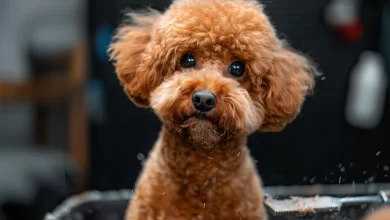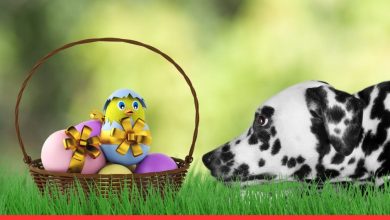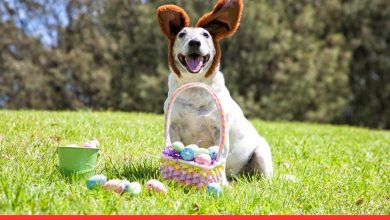Allergic Pet Lovers: 8 Top Low-Shedding Hybrid Dog Breeds


If you’re an avid dog lover but have allergies or simply don’t want to deal with excessive shedding, you might be considering a low-shedding hybrid breed.
These dogs are the result of crossing two purebreds, often with one or both breeds known for their low-shedding characteristics.
In this blog post, we’ll explore the top low-shedding hybrid breeds and what you should consider before making your choice.
Top Low-Shedding Hybrid Breeds
Hybrid breeds, particularly those mixed with Poodles, are often sought after by dog lovers who prefer companions with minimal shedding.
Here are some top low-shedding hybrid breeds:
Maltipoo

Maltipoos are a delightful combination of Maltese and Poodle.
They are loved for their compact size and amicable temperament.
Typically weighing in between 5 to 20 pounds, they fit well in various living spaces, from apartments to larger homes.
One of the perks of having a Maltipoo is their minimal shedding, making them ideal for people with allergies or those who prefer a tidy home.
Grooming requirements are relatively low, but regular brushing is still recommended to keep their coat healthy and tangle-free.
Breed overview
| Size | Small |
| Weight Range | 5-20 pounds |
| Grooming Requirements | Minimal grooming, regular brushing |
| Potential Health Issues | Dental issues, ear infections, patellar luxation |
Shih-Poo

Shih-Poos embody the best of both worlds, blending the loyalty and affection of Shih Tzus with the intelligence and low-shedding coat of Poodles.
Typically weighing between 10 to 16 pounds, they are small to medium-sized dogs that thrive on companionship.
Due to their Poodle lineage, they require regular grooming sessions to maintain their coat’s health and prevent matting.
However, their loving disposition and adaptability make them cherished family pets.
Breed overview
| Size |
Small to Medium
|
| Weight Range | 10-16 pounds |
| Grooming Requirements |
Regular grooming to prevent matting
|
| Potential Health Issues |
Eye problems, allergies, hip dysplasia
|
Goldendoodle

Goldendoodles are renowned for their friendly demeanor and intelligence.
Combining the traits of Golden Retrievers and Poodles, they make excellent family pets.
Despite their larger size, ranging from 50 to 70 pounds, Goldendoodles shed less compared to their Golden Retriever counterparts.
Regular grooming sessions are essential to keep their coat in top condition and prevent matting.
Their affectionate nature and versatility in various environments make them popular choices for households seeking a low-shedding companion.
Breed overview
| Size |
Medium to Large
|
| Weight Range | 50-70 pounds |
| Grooming Requirements |
Regular grooming to prevent matting
|
| Potential Health Issues |
Hip dysplasia, elbow dysplasia, progressive retinal atrophy (PRA)
|
Labradoodle

Labradoodles inherit the energetic and friendly disposition of Labrador Retrievers along with the low-shedding coat of Poodles.
These dogs come in a wide range of sizes, from 30 to 90 pounds, catering to different preferences and living arrangements.
While they shed less than purebred Labradors, they still require regular grooming to keep their coat free from tangles and mats.
Labradoodles excel as family pets, thanks to their sociable nature and adaptability to various lifestyles.
Breed overview
| Size |
Medium to Large
|
| Weight Range | 30-90 pounds |
| Grooming Requirements |
Regular grooming to prevent matting
|
| Potential Health Issues |
Hip dysplasia, elbow dysplasia, progressive retinal atrophy (PRA)
|
Schnoodle

Schnoodles bring together the sturdiness of Schnauzers and the low-shedding coat of Poodles.
Typically weighing between 15 to 45 pounds, they strike a balance between medium and large size.
Regular grooming is essential to maintain their coat and prevent matting. Schnoodles often exhibit a robust build, making them suitable for active families.
However, prospective owners should be aware of potential health concerns associated with both Schnauzers and Poodles, such as hip dysplasia and eye issues, and monitor their pet’s health accordingly.
Breed overview
| Size |
Medium to Large
|
| Weight Range | 15-45 pounds |
| Grooming Requirements |
Regular grooming to prevent matting
|
| Potential Health Issues |
Hip dysplasia, eye issues, Schnauzer-related concerns
|
Yorkiepoo

Yorkiepoos, a delightful mix of Yorkshire Terriers and Poodles, are known for their small size and lively temperament.
Weighing in at a mere 4 to 7 pounds, they are ideal for individuals or families in smaller living spaces.
While shedding is minimal, regular grooming is necessary to maintain their coat’s health.
Yorkiepoos inherit the energy and playfulness of both parent breeds, making them engaging companions.
Breed overview
| Size |
Extra Small to Small
|
| Weight Range | 4-7 pounds |
| Grooming Requirements |
Regular grooming for coat health
|
| Potential Health Issues |
Dental issues, patellar luxation
|
HavanesePoo

Combining the friendly nature of Havanese with the low-shedding coat of Poodles, HavanesePoos are charming companions.
Weighing between 7 to 13 pounds, they fit well into various living environments.
Regular grooming is essential to keep their coat in top condition.
HavanesePoos are known for their social and outgoing personality, making them excellent family pets.
Breed overview
| Size | Extra Small to Small |
| Weight Range | 7-13 pounds |
| Grooming Requirements | Regular grooming for coat maintenance |
| Potential Health Issues | Patellar luxation, dental issues |
Bernedoodle

Bernedoodles merge the friendly and loyal nature of Bernese Mountain Dogs with the low-shedding coat of Poodles.
These larger dogs typically weigh between 50 to 120 pounds, catering to those seeking a substantial canine companion.
Although shedding is reduced compared to purebred Bernese Mountain Dogs, regular grooming is crucial.
Bernedoodles are known for their affectionate and gentle disposition, making them suitable for families.
Breed overview
| Size |
Large to Extra Large
|
| Weight Range | 50-120 pounds |
| Grooming Requirements |
Regular grooming to prevent matting
|
| Potential Health Issues |
Hip dysplasia, elbow dysplasia, bloat, heart issues
|
Considerations for Choosing a Hybrid
When choosing a low-shedding hybrid breed, it’s essential to consider the following factors:
Size and energy level
The size and energy level of a dog play pivotal roles in determining the compatibility with your lifestyle.
Assessing your living space is essential—smaller, low-energy breeds often thrive in apartments, while larger, more active breeds may require spacious yards.
Understanding the dog’s energy requirements ensures that both the pet and owner can enjoy a harmonious living arrangement.
Temperament
Delving into the temperament of the parent breeds is a key step in anticipating the personality traits of your hybrid companion.
Different breeds have distinct temperaments—some may be more laid-back, while others are known for their high energy and playfulness.
Researching these traits can help align your expectations with the dog’s natural tendencies.
Grooming needs
While low-shedding breeds are often sought for their reduced hair distribution, it’s crucial to recognize that grooming needs still exist.
Regular brushing is a common requirement to maintain the health and appearance of the coat.
Some hybrids may need professional grooming services to prevent matting and ensure overall hygiene.

Conclusion
Low-shedding hybrid breeds provide an excellent choice for dog enthusiasts aiming to minimize shedding impact.
By considering key factors such as size, temperament, energy level, and grooming needs, finding a compatible companion becomes seamless.
These breeds offer a balance of desirable traits and reduced shedding, fitting well into various living environments.
Understanding the parent breeds’ temperaments aids in aligning expectations, while awareness of potential health issues allows for proactive care.
FAQs
Hybrid breeds often inherit the low-shedding traits of one or both parent breeds, resulting in less shedding than traditional purebreds.
Yes, even low-shedding hybrid breeds may require regular professional grooming to maintain their coat’s health and appearance.
While low-shedding hybrid breeds may produce fewer allergens than traditional breeds, they are not completely hypoallergenic and may still cause allergic reactions in some individuals.



